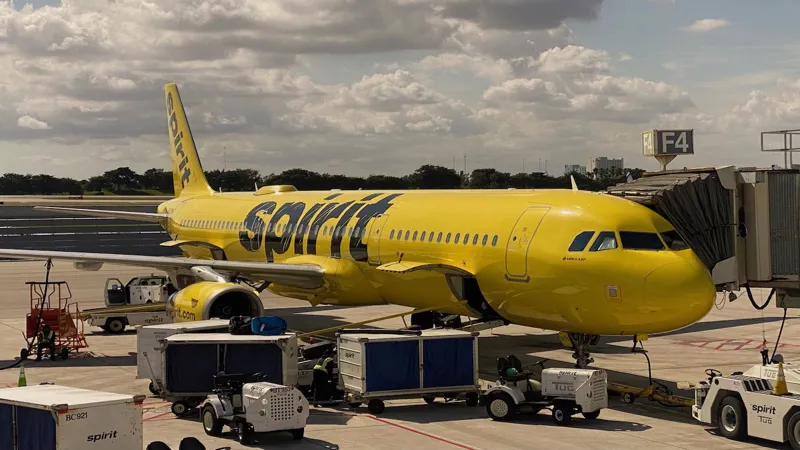In a significant turning point for Spirit Airlines, a US bankruptcy court has confirmed that the ultra-low-cost carrier is poised to emerge from Chapter 11 bankruptcy proceedings in the coming weeks. After grappling with financial difficulties and navigating the complexities of failed merger attempts, Spirit has charted a new course through a take-private deal aimed at securing its future. With a restructuring plan now approved, the airline is set to shed its $1.6 billion debt, paving the way for a revitalized operational strategy that promises to enhance the travel experience for its customers while ensuring long-term sustainability.
| Category | Details |
|---|---|
| Bankruptcy Status | Emerging from Chapter 11 bankruptcy proceedings soon. |
| Bankruptcy Filing Date | November (last year) |
| Debt Restructuring | Restructuring $1.6 billion debt to ensure long-term survival. |
| Recent Merger Attempt | Rejected merger proposal from Frontier Airlines. |
| Approved Plan Judge | Judge Sean Lane approved the restructuring plan. |
| Key Investors | Control transferred to top bondholders including Citadel Advisors, Pacific Investment Management Co., and Western Asset Management Co. |
| Financial Measures | – Existing equity shares voided. – $795 million debt converted into equity. – $350 million raised through new equity shares. – New $300 million revolving credit facility introduced. – $840 million new senior secured debt issued. |
| Future Strategy | Emerging as a stronger airline with financial flexibility to enhance travel experiences. |
| Operational Changes | – Increase less-than-daily routes. – Remove unproductive markets. – Reduce capacity during off-peak periods. |
| Cost-Cutting Measures | Reduction in fleet size and layoffs of around 200 employees. |
| CEO Statement | Ted Christie emphasizes focus on reducing costs while improving guest experience. |
| Customer Enhancements | Introduction of premium economy product, upgraded seating, free WiFi, and complimentary refreshments. |
Spirit Airlines’ Journey Through Bankruptcy
Spirit Airlines has recently made headlines as it prepares to emerge from Chapter 11 bankruptcy. This process began last November when the airline decided to restructure its $1.6 billion debt. By filing for bankruptcy, Spirit aimed to find a way to stay in business and improve its financial health. This journey has not been easy, as the airline faced challenges, including a rejected merger proposal with Frontier Airlines.
The decision to file for bankruptcy is often a last resort for companies like Spirit Airlines. However, it can also be a strategic move to reorganize and come back stronger. With a confirmed plan, Spirit Airlines is ready to transfer control to its top bondholders and focus on the future. This is an important step toward ensuring that the airline can continue to serve its customers and thrive in the competitive aviation industry.
The Approved Restructuring Plan
Recently, a new restructuring plan for Spirit Airlines was approved by Judge Sean Lane, marking a pivotal moment for the airline’s future. Under this plan, major bondholders will take control, which means they will help guide the company as it exits bankruptcy. The plan includes significant financial changes, such as converting $795 million of debt into equity and raising $350 million through new equity shares.
This restructuring plan is essential for Spirit Airlines as it aims to stabilize its finances and regain its footing in the airline market. By involving top bondholders like Citadel Advisors and Pacific Investment Management Co., the airline is set to receive the support it needs. These changes are crucial for the airline’s survival, allowing Spirit to focus on providing better services and experiences for its travelers.
Financial Measures for a Brighter Future
The restructuring plan for Spirit Airlines includes several financial measures aimed at improving the airline’s stability. One key element is the introduction of a new $300 million revolving credit facility, which will give the airline access to funds when needed. Additionally, Spirit will issue $840 million of new senior secured debt to existing bondholders, helping to ensure that the airline has the necessary resources to operate effectively.
These financial measures are designed to equip Spirit Airlines with the tools it needs to overcome its past challenges. By securing additional capital and restructuring its debt, the airline can focus on enhancing its travel experiences for customers. This strategic approach will help Spirit Airlines not only survive but potentially thrive in the future, as it adapts to the changing needs of travelers.
Changes to Enhance Customer Experience
As part of its new strategy, Spirit Airlines is committed to enhancing the customer experience. The airline plans to introduce a premium economy product and upgrade its seating options. This means travelers will enjoy more comfortable and enjoyable flights, which is especially important as the industry recovers from the pandemic’s impact.
In addition to improved seating, Spirit Airlines will also offer free WiFi and complimentary refreshments to its customers. These changes are aligned with new industry trends that focus on providing greater value and comfort to passengers. By making these enhancements, Spirit Airlines aims to attract more travelers and ensure they have a pleasant journey from start to finish.
Adjusting Operations for Better Efficiency
To improve its operations and cut costs, Spirit Airlines is making adjustments to how it runs its flights. This includes increasing less-than-daily routes, which means they will fly to certain destinations less often. Additionally, the airline plans to remove unproductive markets and reduce capacity during off-peak periods, helping to streamline its services and save money.
These operational changes are essential for Spirit Airlines to become more efficient and financially stable. By focusing on routes that generate more demand and cutting back on those that do not, the airline can better allocate its resources. This strategic adjustment will not only help Spirit Airlines save costs but also ensure that it continues to provide valuable services to its customers.
The Impact of Layoffs on Staff and Operations
As part of its restructuring efforts, Spirit Airlines has announced that around 200 staff members will be laid off. This decision is part of the airline’s broader strategy to reduce costs and improve its financial standing. Layoffs can be tough for employees, as they may lead to uncertainty and challenges for those who lose their jobs.
Despite the difficult choice to reduce staff, Spirit Airlines aims to position itself for a better future. CEO Ted Christie emphasized the importance of focusing on strategic initiatives to enhance the overall guest experience. While layoffs are never easy, they are sometimes necessary for a company to survive and thrive in a competitive market.
Frequently Asked Questions
What is the current status of Spirit Airlines’ bankruptcy proceedings?
Spirit Airlines is set to emerge from Chapter 11 bankruptcy soon, following a confirmed restructuring plan approved by the court.
Why did Spirit Airlines file for bankruptcy?
Spirit Airlines filed for bankruptcy to restructure its $1.6 billion debt and secure its long-term survival after facing financial struggles.
What changes will happen to Spirit Airlines after bankruptcy?
Post-bankruptcy, Spirit Airlines will reduce costs, streamline operations, and enhance customer experiences with new services like premium seating and free WiFi.
Who will control Spirit Airlines after the bankruptcy process?
Control of Spirit Airlines will be transferred to top bondholders, including Citadel Advisors and Pacific Investment Management Co., in a take-private deal.
Will there be job losses at Spirit Airlines?
Yes, Spirit Airlines plans to lay off about 200 staff members as part of its cost-cutting strategy.
What new features can customers expect from Spirit Airlines?
Customers can look forward to improved travel experiences, such as upgraded seating, a new premium economy product, and complimentary refreshments.
How much debt will Spirit Airlines convert to equity?
Spirit Airlines will convert $795 million of its debt into equity as part of its restructuring plan.
Summary
Spirit Airlines is set to exit Chapter 11 bankruptcy soon, thanks to a new restructuring plan approved by a US bankruptcy court. The airline, which filed for bankruptcy last November due to financial troubles, will now be under the control of its top bondholders, including Citadel Advisors and Pacific Investment Management Co. The plan involves converting some debt into equity and raising new funds. CEO Ted Christie announced cost-cutting measures, including layoffs of about 200 staff members, while also promising improvements like a new premium economy product and enhanced customer services to attract more travelers.



